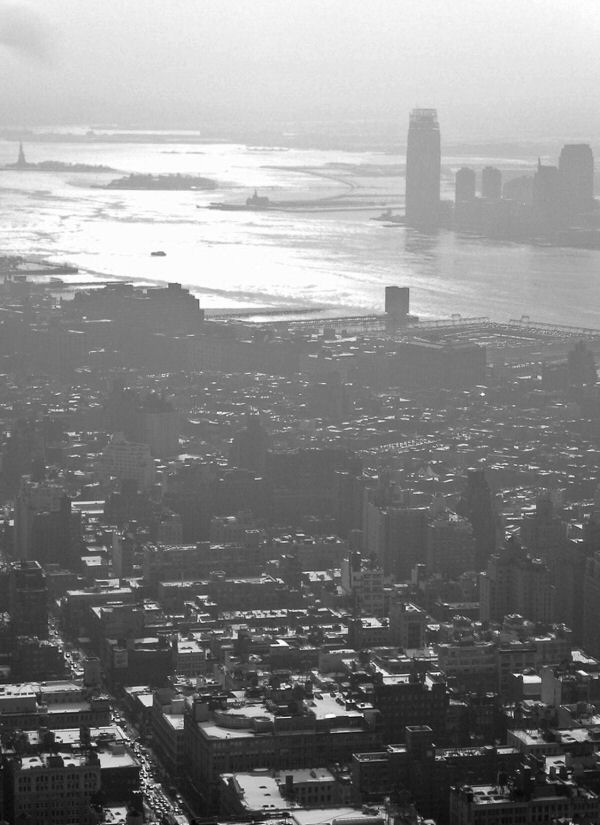Proof of the pudding
We tried out the shadows/highlights/mid-tones tool on a couple of stills taken in New York a few years back – one that we'd given up on until now, and another that we were happy with but thought was a perfect candidate for showing how well (or not) the adjustor worked.The image that needed rescuing was taken from high up the Empire State building and had much of its detail obscured by mist. The adjustor revealed a lot of the hidden detail – encouraging us to enhance the image further.
We manually rotated it half a degree at a time – until we judged the buildings were straight (the auto image-straightener wasn't suitable because there was no long horizontal for it to work on). Then we turned the image to black-and-white by choosing greyscale mode.
These changes only took a few minutes and resulted in an image that (we reckon) would be well worth printing out at A4 size. But judge for yourself – high-res versions of the tweaked image and the original are below.
 The misty New York skyline shot that we set out to rescue…
The misty New York skyline shot that we set out to rescue… …and here it is after Photoshop Elements 4.0 has thinned out the mist,
got the buildings standing to attention, and converted the image to
black-and-white
…and here it is after Photoshop Elements 4.0 has thinned out the mist,
got the buildings standing to attention, and converted the image to
black-and-whiteThe second image – of the Statue of Liberty – is framed down its left side by a wooden upright on a pier, of which little detail is visible. Using the adjustor, we were able in seconds to reveal much of this detail without any significant impact on the rest of the photo – though we actually prefer the look of the dark upright.
Our initial idea had been to use the Magic Selection Brush method but, although, this did quickly and automatically select all of the upright, it also created an off-putting rainbow-coloured border between the upright and the rest of the image.
 We liked the original but knew that bringing out detail in the wooden
upright at the left would be a good test for Elements
We liked the original but knew that bringing out detail in the wooden
upright at the left would be a good test for Elements The detail is there now, but the selection method - Magic Selection
Brush – produced an unacceptable rainbow fringe between the upright and
the rest of the image
The detail is there now, but the selection method - Magic Selection
Brush – produced an unacceptable rainbow fringe between the upright and
the rest of the image A few quick tweaks of the manual adjustor for shadows, highlights and
mid-tones pulled out the detail in the upright without any side-effects
worth mentioning
A few quick tweaks of the manual adjustor for shadows, highlights and
mid-tones pulled out the detail in the upright without any side-effects
worth mentioningWe also tried the auto-red-eye feature and found that it works reasonably well. When it works. Trouble is, it doesn't necessarily pick up every instance of red eye in a shot, especially the less pronounced ones. We devised a workaround, though – copy the face that's been missed out, paste it into a new image, run the auto tool and then paste the tweaked copy back into the original.
That method is faster to carry out than describe, gives a reasonable result and is far easier than attempting to use Elements' manual red-eye tool – which we couldn't get to work well on instances of red-eye that weren't automatically detected and corrected (remember, though, we were using a beta).
Mind you, in contrast with its main rival - Jasc's PaintShop Pro - Elements makes every corrected iris black, rather than offering blue, green, brown and other colour choices.
Also prominent on the new-features list are auto skin-colour, to make faces and body parts shot in artificial light look natural (at least for Caucasians); a WYSIWYG fonts menu that shows what each available font looks like; and a Magic Extractor with "advanced edge defringing" – a tool to copy elements from photos ready for pasting into, for example, composite images, and which works pretty well.
There are also new cataloguing and search options. Find-by-Metadata allows images to be located by criteria such as shutter speed, f-stop and make/model of camera. Face Tagging tries to identify images with faces in them so that users can catalogue them more easily.
There's no suggestion from Adobe that this is genuine face-recognition – the program effectively just looks for face shapes. It won't distinguish between individuals and can be tricked into falsely tagging photos that have face-like objects in them, such as balloons. Also new is a useful ability to manage and tag PDF files.
Many sub-£1,000 cameras are now able to capture images as unprocessed Raw files that make possible more accurate editing than using compressed formats such as JPEG. But Raw's move down market has created a couple of problems.
First, it's significantly increased the number of incompatible Raw formats. Then there's the fact that many of the more affordable Raw-capable cameras are being bought by photographers with little or no understanding of how to edit Raw files.
Such newbie editors are prime targets for Photoshop Elements, so Adobe has responded by increasing the number of Raw formats that are readable with V4. It's also added the very useful ability to write out images as Digital Negative (DNG) files.
Digital Negative is the open Raw format that Adobe created to make archiving easier and more secure - photographers won't have to rely on the makers of their cameras for software that can handle particular Raw-file variants.
Slideshow display options have been enhanced, too. As well as being able to produce on-screen shows from selected images, it's also possible to burn them to CD in VCD format and, if Premiere Elements 2.0 is installed, to DVD as well.
Adobe has also improved the Photo Downloader applet used for bringing in images from cameras and phones. It works even when Elements isn't running and is said to be much faster than before. A further timesaving touch - red eye can be automatically removed from images directly after they've come onboard the PC.
The list of enhancements goes on and on. It's too extensive to detail here, so we'll only mention one more thing. Image noise caused by shooting in low light and/or at ISO camera settings is all too common with digital stills but V4 has a new corrector to handle such compression artefacts in JPEG images.
Adobe's quoted minimum system requirements for Photoshop Elements 4.0 are Windows XP Home, Pro, Media Center Edition (with SP2); an 800MHz Intel or compatible; 256MB RAM; a 16-bit graphics card paired with a 1024x768 display; DirectX 9-compatible display drivers; 800MB of available hard disk space for installation; a CD-ROM drive for installation
Pending our full review of Photoshop Elements 2.0, check out Adobe's press release. Also take a look at the reviewer's guide - you'll need an unzipping program, such as WinZip or WinRAR - and have your say in this HEXUS.lifestyle forum thread.













